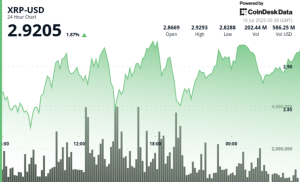Key Insights
- In Q2 2022, secondary sales transactions grew 50% QoQ, while sales volume was up 77% QoQ in SOL terms (up 9% in USD terms).
- The number of NFTs minted grew 46% QoQ in Q2 2022, while primary sales volume dropped 25% QoQ in SOL terms (down 58% in USD terms).
- Metaplex released a proposal for Digital Asset Standard 2.0, which is expected to deliver NFTs in new, more complex multimedia formats at improved speeds and lower costs.
- Metaplex announced a shift in focus towards improving developer support, expanding existing product functionalities, and faster updates to its open-source tooling.
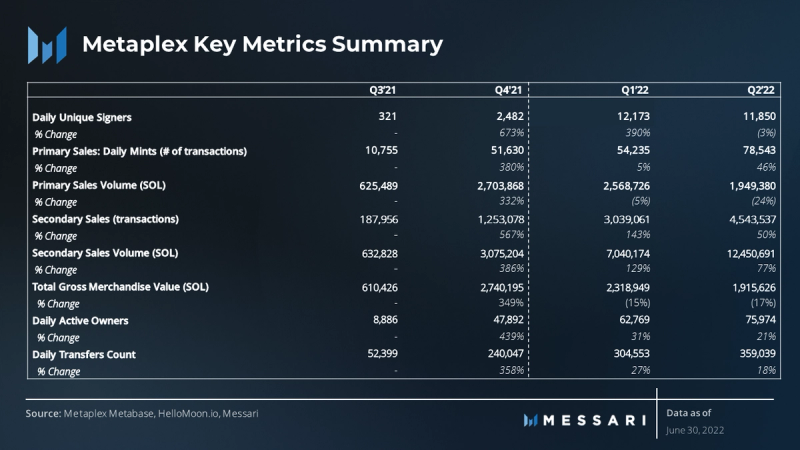
A Primer on Metaplex
Since its launch in June 2021, Metaplex has become the main protocol and permissionless infrastructure layer for NFTs on Solana. It provides NFT communities with development tools and open standards for digital asset issuance and ownership on-chain. The Metaplex protocol maintains several programs and standards that it has developed over time to meet the needs of its community:
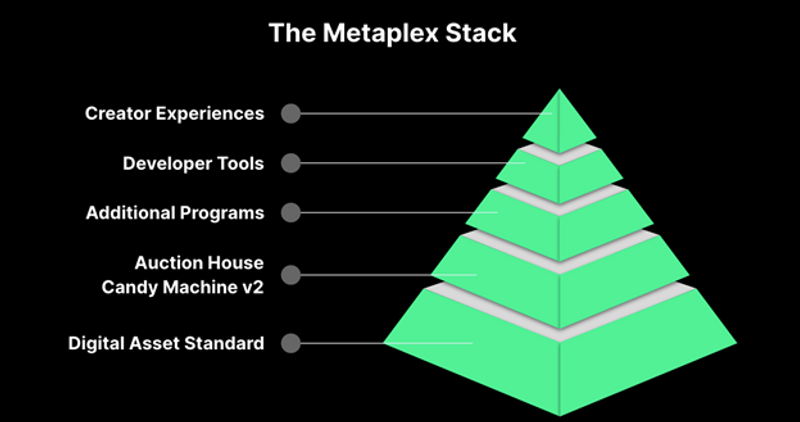
- Token Standard – create NFTs on the Solana blockchain
- Collections – certified on-chain record of NFT collections
- Candy Machine v2 – used to launch generative and PFP collections
- Auction House – decentralized NFT trading
- Gumdrop – allows for massively scaled airdrops of NFTs and tokens
This comprehensive program library is used by creators and developers to interact with an NFT at various stages of its life cycle, from design (Token Standard), to mint (Candy Machine), resale (Auction House), and beyond. The expansion of this library to fit more use cases and developer needs is a key objective set by the Metaplex team, while also continuing to scale the existing programs iteratively based on community feedback. Metaplex is best known for its fully on-chain minting solution, Candy Machine. When paired with one of a growing list of community-driven front-end Web3 applications, such as Holaplex, access to Candy Machine empowers creators to build highly adaptable NFT “storefronts” where NFTs can be designed, minted, and resold. The UI and overall experience for NFT collectors is similar to making a purchase on a popular ecommerce application, such as Shopify – a breath of fresh air in comparison to many esoteric crypto dapps used today.
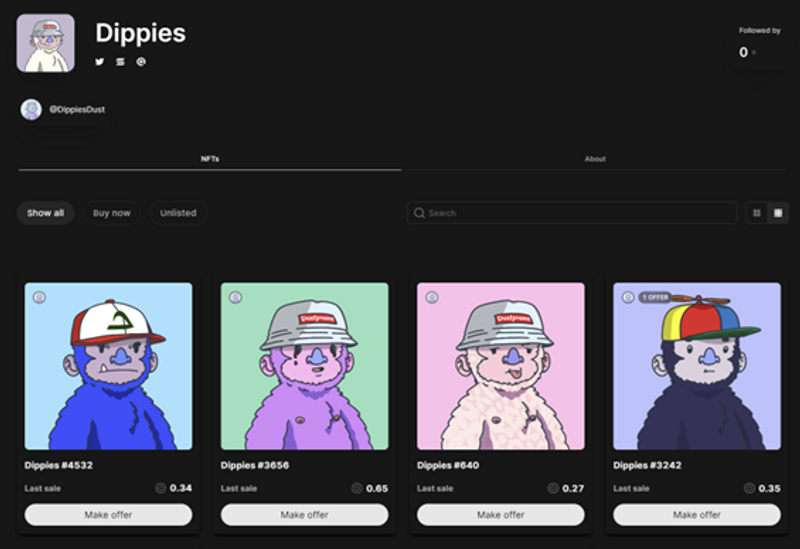
Source: Holaplex, Dippies Collection (@DippiesDust)
The Metaplex protocol stems from an internal Solana Labs initiative in May 2021, aimed at bringing NFT compatibility to Solana’s network. As the popularity of NFTs exploded in 2021, so too did the demand for minting solutions and advanced NFT functionalities on Solana. Ultimately, the team leading the initiative spun off to form the Metaplex Foundation. This new organization was established to support the Solana NFT ecosystem through development of the NFT protocol.
Since Metaplex’s launch, all ~18 million NFTs minted on Solana have been powered by one or more of Metaplex’s programs. Also, all NFTs on Solana conform to Metaplex’s NFT standard, a boon to composability across Web3 applications. Metaplex offers a streamlined experience for users and creators — it pairs its NFT specifications with the greater speeds and affordability of transacting on Solana.
Performance Analysis
Measuring demand across Metaplex’s programs and products requires a variety of proxies, including unique signers of NFTs, minting contracts, secondary sales transactions, user figures, and creator counts.
Signers
The signing of NFT metadata can be used as a proxy to account for the number of unique creators leveraging Metaplex. The underlying NFT metadata — such as mutability, creator, and embedded royalties — is what makes each NFT a useful digital asset. Once the minting is complete, signing the NFT metadata verifies the creator. This system verifies who the actual creator is, rather than listing an arbitrary address as a creator. For an NFT to be verified, it requires the actual creator with their specific wallet address to sign.
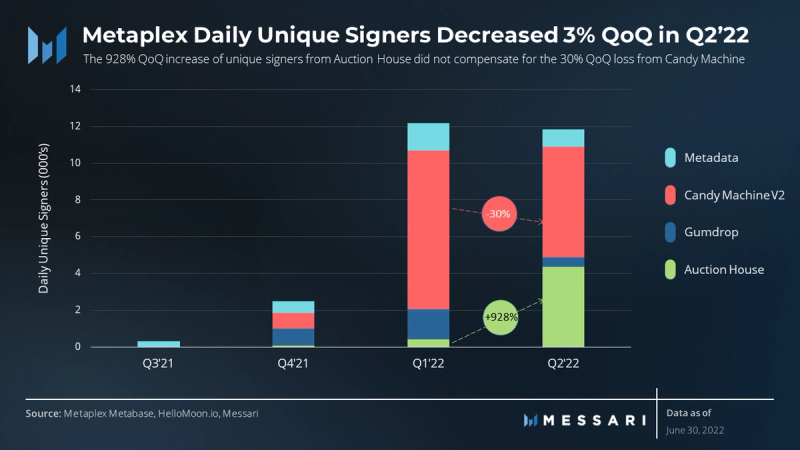
In Q2 2022, daily unique signers only decreased 3% relative to the previous quarter, showing a healthy development despite the overall market downturn. Notably, the 928% QoQ increase of unique signers from Auction House was not enough to compensate for the 30% QoQ loss of unique signers from Candy Machine.
Auction House activity may be explained by the market being flooded with newly minted NFTs in the previous quarter. Given the overall market downturn, transaction activity increased on the secondary markets as participants looked to mitigate further losses or to buy into projects at relatively low costs.
Primary Sales (Minting)
Since its launch in June 2021, the Metaplex on-chain minting program has powered over 16 million out of the 18 million NFTs minted on Solana. Thanks to Candy Machine V1 (launched in late-August 2021) and V2 (launched in December 2021), developers on Solana’s NFT ecosystem have a critical piece of infrastructure at their disposal. Other NFT minting solutions on the Solana ecosystem include: LaunchMyNFT and Magic Eden’s Launchpad (V1 and V2).
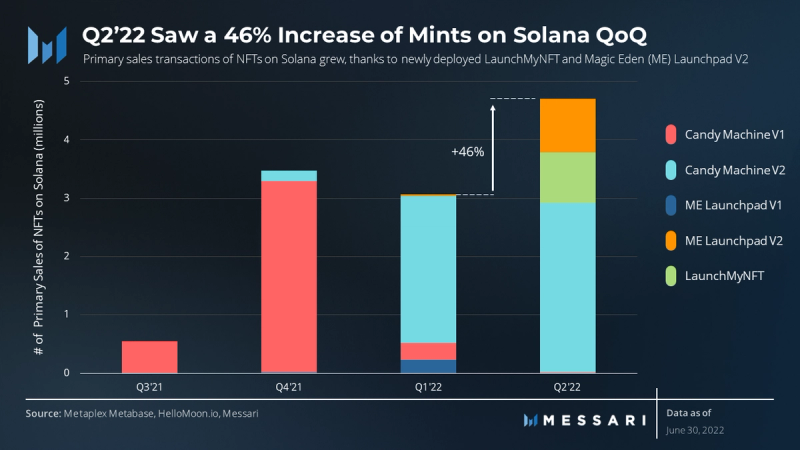
Q2 2022 saw a 46% increase of the number of mints relative to the previous quarter. This increase can be largely attributed to the LaunchMyNFT and Magic Eden (ME) Launchpad programs growing their market share, though Metaplex’s Candy Machine contracts also experienced 3% growth. Notably, Magic Eden forked the Candy Machine program to build their closed-source launchpad in use today. Like many of Metaplex’s programs, Candy Machine is a free, highly-adaptable application that acts as a core component to many third-party applications.
Given the overall market downturn, a more complete picture can be found by analyzing the primary sales volume from mints in both SOL and USD terms.
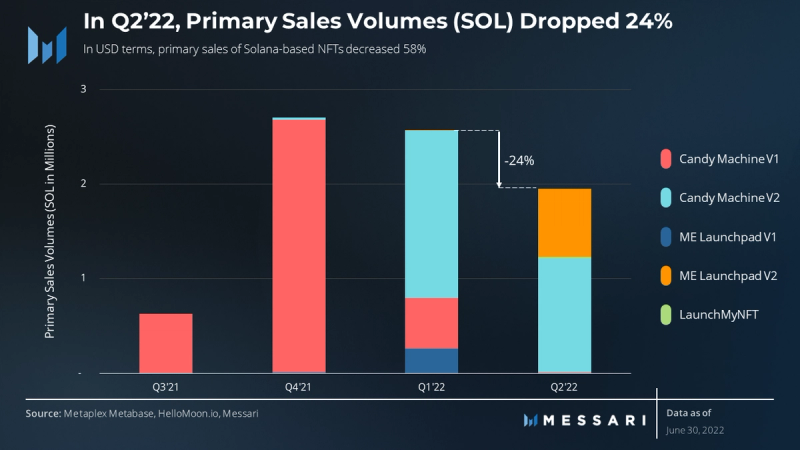
In Q2 2022, primary sales through minting dropped 24% in SOL terms (down 58% in USD terms) compared to the previous quarter. Given that the number of mints went up in Q2 2022, this drop can be attributed to the overall decrease in minting prices.
Secondary Sales
Metaplex works closely with the major Solana-native marketplaces (Solanart and Magic Eden) to ensure a smooth NFT experience for both users and creators.
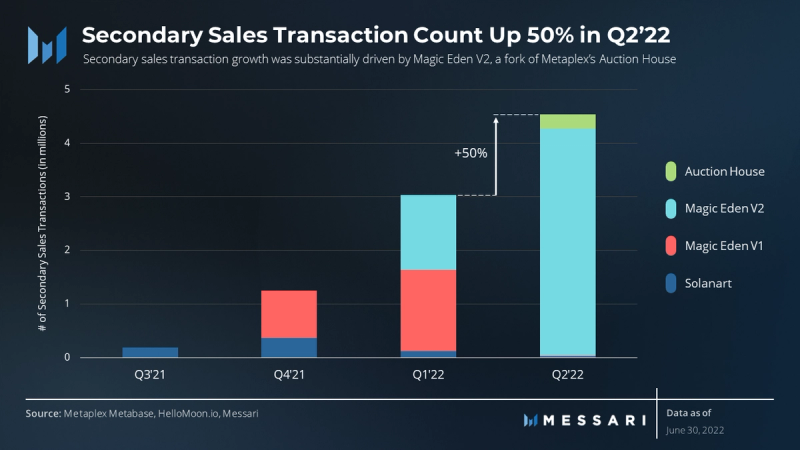
These efforts have translated into secondary (marketplace) sales transactions that increased 50% in Q2 2022 relative to the previous quarter. This growth has been dominated by Magic Eden V2, a forked closed-source version of Metaplex’s permissionless Auction House program. Pictured by the green bar above, the original Auction House smart contract was launched by smaller marketplace operators in Q2 2022, after officially being released in November 2021.
Auction House volumes are a potential growth engine. As additional independent third-party marketplaces adopt the open-source program as their backend infrastructure, Auction House is expected to facilitate an increasing number of transactions between buyers and sellers. This dynamic may further facilitate escrowless transactions, boosting the Web3 ideals of trustless networks and reducing the need for rent-seeking middle-men. Currently some large marketplace operators, like Magic Eden, use an escrow-based trading model to facilitate secondary sales. With wallet hacks becoming an ever more present risk on blockchains, a push to champion escrowless trading as a critical opsec improvement is likely to gain momentum – likely a boon for the proliferation of Metaplex’s Auction House.
One can expect greater adoption for Auction House amongst new marketplace operators to boost transaction counts, especially as lower-fee marketplaces begin to emerge. In addition, the combination of NFT prices and heightened volatility may drive further growth in secondary sales transaction counts over the next several quarters.

In contrast to primary sales volume, secondary sales volume increased 77% in SOL terms (up 9% in USD terms) in Q2 2022 relative to the previous quarter. This increase can be attributed to MagicEden V2 accounting for over 93% of the quarterly secondary sales transactions, alongside Auction House accounting for 6%. The merchandise value of NFTs sold on secondary markets puts this growth into perspective:
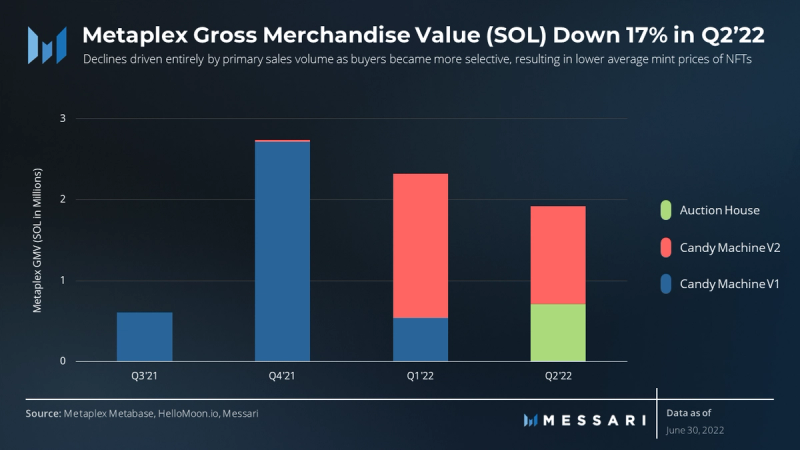
In Q2 2022, the total gross merchandise value (GMV) represents the sum of sales figures across all of Metaplex’s programs (currently only Candy Machine and Auction House have quantifiable sales figures). GMV decreased 17% in SOL terms (down 54% in USD terms) QoQ amid the overall market downturn. The lower average selling prices of NFT mints in primary sales are driving this decline, even as the daily number of NFTs continues to grow.
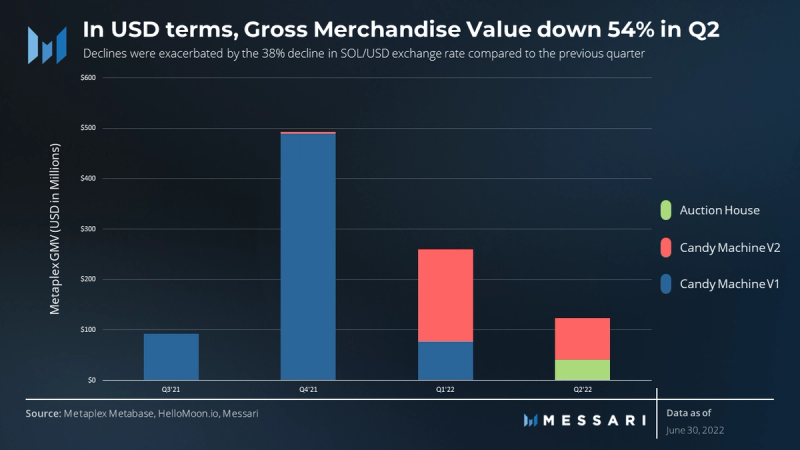
This inverse relationship between GMV and total NFTs minted is best explained by the proliferation of “free mint” projects. These free mints attract NFT buyers who might otherwise be more risk-averse and selective, generally, in a cooled-off market. The resulting drop in average selling price explains the decrease in GMV, even when pricing in the native mint currency (SOL). The declines are significantly worse in USD terms because they are compounded with the sharp decline in SOL (SOL average price fell ~38% QoQ to $66 in Q2’22).
Thus far, the demand for Metaplex has been measured according to a suite of development tools and open standards for digital asset issuance. However, besides issuance, Metaplex enables the on-chain ownership of digital assets. Thus, the number of owners of Metaplex-enabled NFTs could also be a proxy for current network activity.
Activity
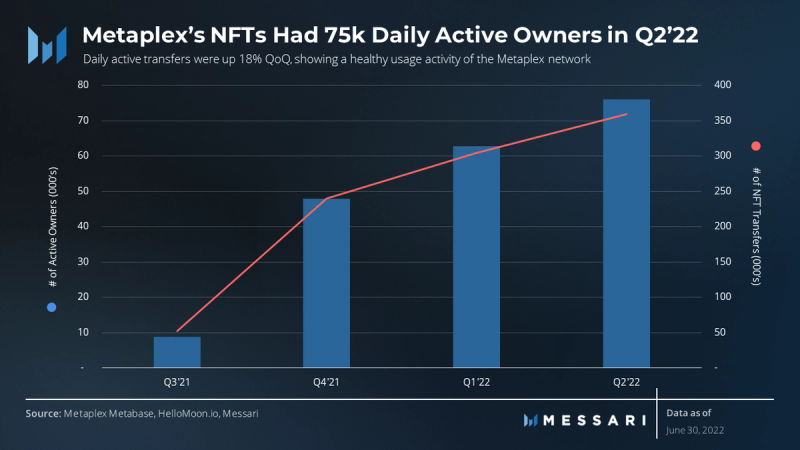
Q2 2022 saw a daily average of almost 76,000 owners of Metaplex-enabled NFTs who bought or sold an NFT each day (i.e., daily active owners), up 21% from the previous quarter. In addition, the average number of daily transactions grew 18% QoQ. Overall, the increase in the number of unique wallet addresses and NFT transactions on Solana on a daily basis shows a healthy usage activity for the Metaplex network.
Qualitative Analysis
Metaplex Ecosystem: Notable Events
Strata Protocol Partnership and Other Anti-Bot Features
In June 2022, Metaplex announced a key integration with Strata Protocol’s Dynamic Pricing Mint tool. With this tool, mints function like a real-time Dutch auction — the price increases and decreases based on demand. This feature is designed to make pricing dynamics more unpredictable, which would discourage bots from easily exploiting the market.
These anti-bot measures came after the Solana network experienced forced downtime. The periods of downtime have been attributed to heavy botting on a highly anticipated mint using Candy Machine. These growing pains are a consequence of the rapid traction experienced by the Metaplex protocol thus far. The protocol imposed a botting penalty in April 2022 to address bot attacks amidst the snowballing adoption of Solana-based NFTs. Prior to this penalty, bots would fire off numerous invalid transactions (at little-to-no cost) in an effort to win a mint while spamming the network. The botting penalty punishes botters by automatically charging a nonrefundable fee of 0.01 SOL for failed transactions. The fee is then collected by the Candy Machine program.
Roadmap and Opportunities
Shifting Focus Towards Creator Tools and Support
In mid-July, an official announcement on Metaplex’s discord server detailed a shift in focus and the reallocation of resources towards several unmet needs for Solana’s NFT ecosystem and the Metaplex Community. Specifically, these needs are include:
- Improved documentation, reference implementations, and tutorials
- Expanded functionality of SDKs for JS, iOS, and Android
- Faster updates to open-source tooling and CLIs
The announcement included the decision to discontinue its original objective of creating an “all-in-one storefront.” Because many other community-driven projects already offer this functionality, Metaplex can better allocate its time and resources toward strategic areas. For instance, one focus is to create smaller individual reference components, SDKs, and improved documentation. Moving forward, Metaplex will likely emphasize network speed.
Digital Asset Standard 2.0
The Metaplex Foundation released a draft proposal for the Digital Asset Standard 2.0 spec and sought community feedback on GitHub. This improvement to the original Metaplex NFT standard allows more capabilities and use cases to be built. Several salient features of the new standard include:
- Dynamic NFTs that can transform and/or react to events through “extensions”
- Custom solutions facilitated through a standard that’s more adaptable for creators across a wider gamut of NFT use cases
- Lower minting costs by up to 5x through “compressed NFTs”
- A new read API for improved performance (e.g., quicker API calls)
- Enforceable royalties at the standards layer (protects creators from “royalty stripping” on sale transactions)
Per the GitHub Announcement, the standard can be broken out into two main components:
- A Digital Asset Smart Contract that represents an “owned asset” on-chain and allows the creation of Web3 use cases such as video, music, dynamic HTML content, 3D assets, etc.
- An Extension Smart Contract that enables builders to enhance the functionality of the NFT by integrating with other components that add an extra layer to digital assets, e.g., financial logic layer.
This upgrade supports Metaplex’s recently-stated commitment to improving the Protocol’s value-add for the Solana NFT community.
Maximizing Solana’s NFT Ecosystem
Metaplex seeks to become a successful decentralized app protocol through a deep vertical integration into a single ecosystem. This approach is testament to the belief held in Solana as a robust NFT chain. Metaplex has plans to deepen its roots within the Solana NFT ecosystem, and the community may continue to count on this relationship for the foreseeable future.
Further Decentralization & DAO Formation (Unconfirmed)
Though formal details on a potential token airdrop have not been announced by the Metaplex team, the protocol will likely take steps to decentralize its governance. The decentralization may happen over time, as the underlying programs and the Metaplex community matures. The private “token round” designation attached to the $46 million strategic capital raise announced in January 2022 indicates that a public token distribution event may be in the cards in the near future.
Additionally, a DAO would further align Metaplex’s organizational structure with the core values of decentralization. As with many other decentralized apps, the early adopters, collaborators, and community members of Metaplex may find that their early contributions will be rewarded with DAO governance.
Closing Summary
The Metaplex protocol just passed its one year anniversary since its late-June launch. In this time, Metaplex has witnessed and actively contributed to the impressive milestones achieved for Solana-based NFTs. Throughout its short history, Metaplex has innovated continuously and, as a result, has been rewarded by becoming a household name within the Solana NFT ecosystem for creators and collectors alike.
Despite recording growth in a number of categories, such as Auction House volumes and NFT mints, Q2 2022 was not without its challenges. The sharp decline in gross merchandise volume across its products (especially in USD terms) highlights the “risk-off” sentiment reducing user appetite across the digital assets space.
In this dreary market environment, one would be hard pressed to identify, across any chain, a decentralized protocol that has commanded such a dominant position or has become so widely accepted as the NFT standard within a given ecosystem. Thanks to its commitment to its community, emphasis on decentralization, and dedication to reinvention, Metaplex continues to stand out amongst its peers — or rather, the lack thereof.
Looking to dive deeper? Subscribe to Messari Pro. Messari Pro memberships provide access to daily crypto news and insights, exclusive long-form daily research, advanced screener, charting & watchlist features, and access to curated sets of charts and metrics. Learn more at messari.io/pro
Let us know what you loved about the report, what may be missing, or share any other feedback by filling out this short form.
This report was commissioned by Metaplex, a member of Protocol Services. All content was produced independently by the author(s) and does not necessarily reflect the opinions of Messari, Inc. or the organization that requested the report. Paid membership in Protocol Services does not influence editorial decisions or content. Author(s) may hold cryptocurrencies named in this report. Crypto projects can commission independent research through Protocol Services. For more details or to join the program, contact ps@messari.io. This report is meant for informational purposes only. It is not meant to serve as investment advice. You should conduct your own research, and consult an independent financial, tax, or legal advisor before making any investment decisions. The past performance of any asset is not indicative of future results. Please see our terms of use for more information.

